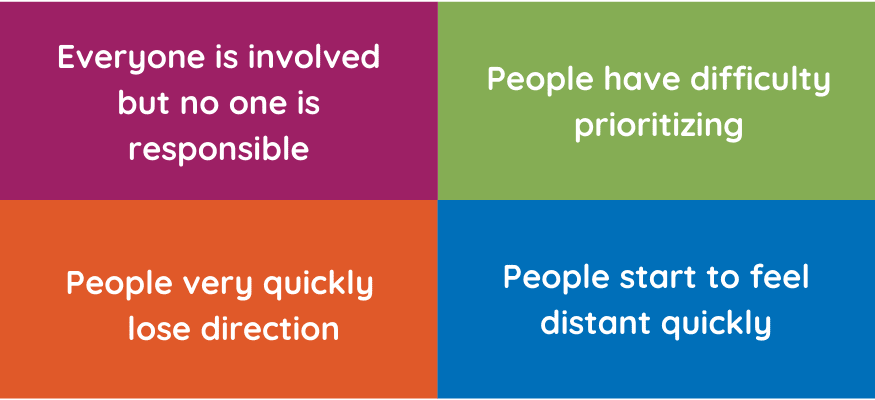

Some of the common pain points that teams experience with virtual work are reminiscent of college or university experiences with group projects when someone essentially ghosts the team: they hardly communicate and only drop in on the project at the end to get the grade.
Without that person’s contribution and feedback, the rest of the team struggles to stay focused on the task at hand, either complaining about the missing teammates lack of engagement or losing that sense of team morale to prioritize the project.
Workplace leaders and teams have common complaints about virtual work that echo that of a failed university group. These can include:

- “Everyone is involved but no one is responsible” – a common pain point that many teams are able to identify but struggle with addressing
- “People very quickly lose direction” – this can include loss of direction on the goal/objective of the project or misunderstandings with needed outputs
- “People have difficulty prioritizing” – with so many projects on the go and less frequent (or non-existent) team check-ins, prioritization can get muddy
- “People start to feel distant quickly” – how can we maintain team motivation when everything is virtual and casual team engagement is low?
We’ve come to a point where it’s time to reflect, so we can regroup and do what works as we move into 2021. Not by reflecting on how challenging the past year has been for overall wellness, our local economies, or any of the other unintended consequences of this tumultuous and downright hectic pandemic marathon, but on how we’ve been staying effective throughout it all.
I’ve done a deep dive into the world of “virtual effectiveness” to see how the shift to #WorkFromHome (WFH) culture (that started in March of 2020) has adapted to a prolonged and almost year-long journey for the standard knowledge worker. From this research, I’ve extrapolated five themes that have surfaced, with a comparison between the first half of the pandemic and where we are at now.
1. Wellbeing is #1
Some might say that the overarching theme of this year was wellbeing. Your employees’ physical and mental health are priority #1 in the workplace if you want an effective team.
One of the biggest challenges to virtual work is social isolation, and with the pandemic making it harder to engage socially outside of work, it’s important for leaders to identify this as an integral part of your team processing their new, virtual work roles. Early pandemic research from Microsoft and Deloitte reference the need for leaders to foster connection with their team. Simply starting meetings with a personal question, like “how was your weekend?”, is a great way to embody a personal touch. The Harvard Business Review discussed the impact that social isolation can have on employees, causing some to “feel less ‘belonging’ to their organization, and can even result in increased intention to leave the company.” They, along with a comprehensive research study in June of 2020, suggested that in order to mitigate social isolation in employees, leaders provide opportunities for online social interaction (like seasonal events, happy hour, pizza parties, book clubs, etc.).
As a leader, you’re the one who’s setting the bar for working online effectively. Having good habits and role modelling proper work-life balance inspires your team. Back in March, Fast Company advised that the CEO of a company “set an example of going offline for the time when work isn’t being done.” You want your team to practice good work hygiene, leaving work at the desk when you walk away from it. It was also widely proposed at the start of the pandemic that leaders encourage their employees to set up their virtual workspace in a quiet, distraction-free setting.
Another thing for leaders to consider is bringing corporate wellness initiatives into the work-from-home environment. Promoting mindfulness, breathing, meditation, physical exercise, and other self-care activities will go a long way in energizing your team. Our team at Pollinate was lucky enough to learn a variety of self-regulation/breathing techniques from Kathy Somers at The Stress Management and High Performance Clinic in Guelph, Ontario. Spending some of your employee wellness budget on similar services from outside vendors will not only promote wellness, but also keep the team from feeling isolated from each other.
2. The Rules of Engagement Have Evolved
In April 2019, Google published an insightful article that summarized what they called “distributed work” and how teams can stay connected, happy, and engaged in order to be effective when working from a distance. One of the biggest takeaways was that boundaries are really important for team success. The article recommended that team members should set out preferred working hours for when they like to take meetings/calls. They also suggested that 48 hours of responsiveness to emails, chats, and voicemails was a big “rule” when it comes to engaging with clients and your team.
Similarly, an article titled “A Guide to Managing Your (Newly) Remote Workers” from the Harvard Business Review in March 2020 found that managers who establish rules of engagement have more efficient and satisfied teams. This is especially true for when expectations are set for the “frequency, means, and ideal timing of communication for their teams.”
We’ve seen the rules of engagement evolve since the beginning of the pandemic. “Virtual coworking” has become a highly recommended workplace activity. A start-up called Ultraworking suggests that attending a “work gym” is the key to social accountability and virtual workplace effectiveness. Having strangers work with you in regular scheduled intervals (with the added bonus of optional socializing) is the new in-person brainstorm.
But even if you don’t have the means to attend a “work gym”, you can still find someone on your team that can act as a “work buddy” (not dissimilar to a gym buddy). The Harvard Business Review suggests that teams who use video calls to simply work in each other’s virtual presence are more likely to perform better. Better accountability, opportunities for spontaneous collaboration, and less social isolation are just some of the benefits.
3. New Strategies for Virtual Meetings
Making sure your virtual meetings are well structured and frequent will almost always result in a productive session – no surprise there. A report created by Deloitte in March 2020 provides a basic framework for meeting success, including the highlight that leaders should schedule compact/shortened sessions to brainstorm and work through big projects. Long, drawn out meetings usually result in an uninspired and distant team. Utilizing breakout sessions was also recommended to chop up long meetings, providing teams with an opportunity to connect in small groups and stay engaged with one another for increased focus.
Pollinate Tip: See my top 5 Tips to Facilitate a Virtual Meeting Like a Boss.
Maximizing your team’s schedule is now at the top of every leaders’ mind. This year has been overflowing with video meeting overload and Zoom fatigue is rampant across the board. To mitigate this, time management coach Elizabeth Grace Saunders (via the Harvard Business Review) suggests that teams try to work recurring meeting items into existing meetings to maximize on the daily schedule. You might decide to occasionally reformat existing team check-ins by shifting the focus from operations to strategy which will ensure everyone is aligned on business direction, project management, and other important (more siloed) agenda items.
An important piece of research from 2016 in the Academy of Management Discoveries journal discusses the concept of “burstiness” (or “rapid-fire bursts of communication”). Christoph Riedl & Anita Williams Woolley suggest that if teams schedule these bursts in blocks of availability to coordinate attention to a specific project/challenge, quality solutions are produced in quick succession. To support fast paced meetings, it’s also important to set ground rules for your virtual meeting. Voltage Control lists out some important rules every leader should implement into their meetings, including keeping muted unless it’s your turn to speak and no multitasking, even if it’s quick.
4. IT Innovation
When teams moved to virtual work in March, most were completely new to the concept of being part of (let alone hosting) an online meeting. “Is Zoom like Skype?” and “how do I turn on my video?” were common questions we’d hear when this all first started. Preliminary research from Microsoft suggested that we capitalize on instant messaging applications (i.e., Google Hangouts, Slack, etc.) to stay in the loop. Using the “status” message on these channels to show when you’re around was also recommended. The concept of the “virtual watercooler” was a hot topic at the start of the pandemic, with Fast Company suggesting that organizations create a separate non-work related instant messaging channel to create informal opportunities for teams to connect on personal topics.
Many thought leaders were thinking ahead on how to leverage these new technologies when needed. Forbes suggested matching the communication channel with the need, supporting the notion that video does not always have to be on for effective meetings. Sometimes email/instant messaging can be just as effective as a virtual meeting. Note taking was also something that Deloitte recommends as a must for any virtual team meeting – to establish buy-in from the project team and mitigate the need for meetings that repeat the same content.
Pollinate Tip: Our Virtual Knowledge Networks are a secure way to curate resources, promote discussions and organize initiatives for effective virtual collaboration.
There have been a ton of developments with the way people engage online. The whiteboard/collaborative document (i.e., Google Docs/Sheets, Mural, Miro, etc.) is a very important tool nowadays, not only for version control but also to keep teams engaged while working on a project together. Utilizing a “project management approach” to managing yourself and your team is also working wonders for the virtual team. Applications like Trello make task-management highly visual (and simple) and Doodle (or Calendly) make scheduling a breeze.
Back to the concept of burstiness, Christoph Riedl & Anita Williams Woolley also suggest that hosting audio-only meetings while working on a whiteboard/collaborative document is much more effective for task-focused conversations. This echoes the early findings that matching the comms channel to the need is necessary. Voltage Control discussed back in September that organizations should have a “Should We Even Have a Meeting” checklist to identify whether the intended content of a meeting even needs a meeting at all. Lastly, cybersecurity is a real threat in today’s digital age. A massive report from OneLogin on the State of Remote Work suggests that cyber attacks targeting remote workers are on the rise. It’s important as a leader to protect your team by enforcing multi-factor authentication, the use of VPNs, and developing secure remote working policies.
5. Agile Teams are Effective Teams
Sometimes working online can feel like you’re talking to a computer. Even though you technically are, it’s important to remember that there are real-life people behind those floating heads. Establishing rapport makes people feel more engaged overall. In Google’s 2019 article about distributed work, one of the top tips was to work on building your remote connections and establishing rapport before jumping into the content of a meeting. Fast Company also suggests that CEOs should “[show] their personal side and not just their professional side” at work to maintain approachability and make the rest of the team feel safe and inspired in their (newly) virtual role.
Virtual teams can struggle with the new paradigm shift on how success is measured as well. Working from home means leaders can no longer evaluate employees effectiveness with how many hours they spent in the office. Forbes suggested that leaders should revise and share clarity on the businesses’ new model on measuring success. Measuring results and accomplishments rather than hours worked proves more engaging for teams in the long run.
Pollinate Tip: A quick and easy way to engage teams and break down silos is to promote mentorship across your team. Our mentorship programs are a fast way to transfer knowledge, build diverse organizations, and improve operations.
New ideas have emerged that support a more effective and engaged team. Promoting interdependent projects that require the team to work together fosters team trust in virtual collaboration. Even if it’s a mini-project that gets everyone working together (and out of those silos) you’ll reap the benefits regardless of the outcome. From this same research report in Elsevier Public Health Emergency Collection, fostering an inclusive virtual work culture through in-depth conversations and one-on-one sessions builds up your team’s confidence to stay engaged with work for longer.
An agile team is an effective team. In Forbes’ article on fostering professional development and community for remote teams, a key takeaway is to update internal processes to support agility. They mention that in order to set your team up for success in this new environment, leaders should “[define] clear objectives and outcomes that provide high-level guidance while allowing flexibility.” Gone are the days of rigid protocols and processes for every task – now that the majority of workers are online, transparency and accountability are key.
Our next stretch into 2021 is a pivotal point for effectiveness. We’ll be tested, yet again, at staying agile with whatever comes our way. The year ahead could bring dramatic shifts to the way we work, but through it all we will remain resolute in bringing you the best effectiveness advice out there. If there’s anything we’ve learned from 2020, it is to pursue what matters most – for your team, yourself, and your inner circle. Stay safe and stay well.



